Saturday, July 29, 2023
NYC eyeing $225M deal to house migrants in famed Roosevelt Hotel: sources

https://nypost.com/2023/05/09/nyc-eyeing-225m-deal-to-house-migrants-in-roosevelt-hotel/
Hundreds of asylum seekers could be poised to reside at New York City’s Roosevelt Hotel in the coming weeks, with the Big Apple eying a deal to turn the iconic building into its latest migrant shelter, The Post has learned.
The Adams administration is in talks to convert the historic Manhattan hotel, located at 45 East 45th Street, into an emergency shelter as the city grapples with the ongoing surge of migrants, several people familiar with the matter said Tuesday.
“While there have been few details revealed about this proposal, City Hall has confirmed to me that there are significant discussions taking place to provide temporary housing for migrant families, as well as other services at this location,” Fred Cerullo, president of the Grand Central Partnership, said.
The Big Apple reportedly offered to secure 1,025 hotel rooms for migrants on a daily basis for 36 months at the rate of $200, according to Minute Mirror, a Pakistani news site. The Post has not been able to independently confirm these details.
That’s an estimated eye-watering total of $225 million over three years.
The 1,000-room luxury hotel, owned by Pakistan International Airlines, shuttered in 2020 due to financial strains brought on by the COVID pandemic and has yet to reopen, though a handful of businesses still operate storefronts on the ground floor of the building.
Multiple construction and cleaning crews were spotted coming-and-going from the hotel lobby on Tuesday, including a handful of workers who were spiffing up the front entrance.

“Everyone is under the gun to get everything done. To make it suitable living conditions for people,” according to one contractor, who said his company was hired a week ago to make sure the plumbing is adequate.
“It’s not terrible. It’s old and the building is outdated.
“But it was an operational hotel up until a few years ago so it’s not in shambles but it needs some TLC.”
The contractor, who didn’t want to be named, said it was no secret among all the workers that they are getting the space ready to house migrants.
He added that some workers were tasked with setting up an intake facility in the hotel’s once-grand lobby.

“Today it was mostly just setting up the lobby for chairs for intake and how they’re going to sort things out to get them rooms,” the worker said.
City Hall did not respond to The Post’s request for comment about the deal.
Still, Manhattan City Councilman Keith Powers, who has been pushing for the hotel to be designated a historic site, said he was aware of the city’s plans.
“It’s an iconic location worthy of preservation and this is helping to solve two problems at the same time by preserving it as a hotel and addressing an ongoing crisis but we have to make sure that opening a location of this size is done in an appropriate fashion,” Powers said.
The hotel, which first opened its doors in 1924, has been the backdrop for a string of Hollywood films — including “Maid in Manhattan,” “Malcolm X,” “Wall Street,” “The French Connection,” “The Irishman” and “Man on a Ledge.”
It was also the setting for Guy Lombardo’s New Year’s Eve ballroom performances for three decades until 1959.
Despite being named after President Roosevelt, no commander-in-chief ever stayed there.
“The migrants are going to think they came to like Hollywood or something when they start walking around inside this hotel. I mean, it’s going to be crazy,” a member of the hotel’s security staff told The Post.
“The lobby is beautiful. They don’t need to do anything.
“The rooms are outdated but they’re all gorgeous.
“This place is huge, a whole city block.
“The migrants are coming here from Venezuela and wherever else, they’re going to think they landed in heaven.
“They’re never going to want to leave.”
The hotel’s current owners, PIA, purchased the building back in 2000.
The site has remained dormant ever since it was shuttered three years ago due to the financial fallout of the pandemic.

According to local media reports, the Pakistani government revealed plans earlier this year to turn the site into a “mixed-use high rise tower.”
Security guards outside the hotel claimed the owners had signed a three-year contract with the city to house migrants.
The potential deal involves setting aside roughly 500 hotel rooms for migrants, the guards added.
“The plan is to, you know, get through this slow period and then after three years of, you know, housing the migrants, then they’re going to open it back up as a regular hotel,” one claimed.
The city has turned a number of the city’s hotels into migrant shelters amid an influx of asylum seekers over the last year.
Currently, there are 126 emergency shelters — typically hotels — operating as emergency shelters, as well as another eight barracks-style facilities.
Nearly 61,000 migrants have flooded into the city since last spring and more than 37,000 of them are currently living in the city-operated or city-funded shelter facilities.
The Holiday Inn in Manhattan’s Financial District has had a tough few years, shutting twice during the pandemic and struggling with too much debt. In November, owner Jubao Xie put the 50-story hotel, the world's tallest Holiday Inn, into bankruptcy. Just weeks later, New York City Mayor Eric Adams’s administration came with a lifeline: It wanted to rent all 492 rooms to house roughly 15,000 migrants over the next 15 months. The hotel, typically charging $110 a night, would get 73% more, or $190 a room. Plus, the city would guarantee full occupancy at a time when it expected to be just 70% full. BloombergCityLab Phoenix’s Rapid Growth Magnified Its Vulnerability to Heat Why London’s ULEZ Emissions Charge Became a Political Football Midtown Manhattan Is Literally New York’s Hottest Neighborhood Singaporeans Turn Empty Spaces in Public Housing Into Libraries, Gardens Not only would the Holiday Inn be a “good corporate citizen” by agreeing to the contract, it was expected to rake in a “significant” $10.5 million profit, according to a bankruptcy filing. The judge on the case urged the hotel operator to take the deal. The Holiday Inn declined to comment. The deal with the city is one of more than 140 that is now benefiting the hospitality industry beyond filling otherwise empty rooms: An analysis of records shows that in many cases, the city is paying premium daily rates to house the migrants — forking over $311 a night at the two-star Holiday Inn Express on Kings Highway in Brooklyn and $200 a night at the once-posh Roosevelt Hotel in Manhattan that shuttered during the pandemic. The hotels range from seedy, “hot-sheets” rented by the hour to historic, century-old Midtown Manhattan palaces that have made cameos in Hollywood movies. They’re helping house the more than 72,000 migrants who’ve entered the five boroughs over the last year from Venezuela, El Salvador and other Latin American countries. “It is a feature of emergency procurement that you pay through the nose,” City Comptroller Brad Lander said of the city’s arrangements with hotels. “If you could reduce the cost of hotel rooms even modestly you would save a lot of money.” Source: United States Bankruptcy Court Southern District of New York. Golden Seahorse, LLC dba Holiday Inn Manhattan Financial District, Debtor. Case No. 22-11582 (PB) The cost of housing migrants is so extraordinary — an estimated $4.3 billion between April of 2022 and July 2024 — that Mayor Adams says he must cut city services to afford it. To manage those expenses, Adams says the city is planning to trim services such as library hours, meals for senior citizens, re-entry programming for Rikers Island prisoners, and free, full-day care for three-year-olds. Last month, Adams also sought to unwind the city’s right to shelter, which entitles the migrants to housing within 24 hours of their arrival. Yet city property records and travel booking websites show that many of the hotels now housing migrants historically rented rooms for far less than the current citywide average hotel room rate of $316.94. Several were in significant debt, some were the sites of sordid incidents — like sex trafficking, assault and drug arrests — and many earned scathing reviews from previous guests on hotel review websites like Trip Advisor and Yelp. Data provided by the comptroller’s office shows 37 hotels contracting directly with the city’s Department of Homeless Services are being paid daily rates ranging from $55 a day to $385 per day, sometimes far in excess of what the hotel rooms might otherwise rent for. Adams Administration spokesperson Kate Smart said in a statement that each contract negotiation was unique, and that city officials are seeking out competitively priced sites to house the migrants. Those discussions include janitorial services, food services and other facilities the city can use including non-residential portion of the hotels. She also acknowledged the city is occasionally dealing with opportunistic operators. “We have absolutely rejected proposals on the basis of cost,” Smart said. “As the mayor has discussed, we've unfortunately dealt with landlords looking to price gouge and benefit off of this crisis as well.” On average, the city is paying $256 each day to house each migrant family, officials said last month, compared to the $136 to $188 per day it pays to provide shelter for other homeless New Yorkers. NYC Pays Premium to House Migrants in Hotels Officials have struck emergency deals for shelters across the five boroughs Source: Office of the New York City Comptroller. Note: City per diem rate is calculated by the comptroller's office and may include the cost of food and other services. Emergency Deals The city declared a state of emergency in October 2022, meaning its normal competitive bidding and other contract safeguarding processes — characteristically labyrinthine and time-consuming — are suspended to ensure flexibility when culling deals to provide services to the new arrivals. Source: United States Bankruptcy Court Southern District of New York. Golden Seahorse, LLC dba Holiday Inn Manhattan Financial District, Debtor. Case No. 22-11582 (PB) These shelter agreements have been a boon for some segments of the struggling hotel industry, which is only now approaching a return to normalcy after the pandemic halted travel and left rooms empty. Occupancy rates are at 85.9%, still slightly below pre-pandemic levels, and 47 hotels with nearly 10,000 rooms remain closed citywide, according to STR. The city has roughly 130,000 hotel rooms in total. Of the more than 140 hotels the city is using, at least 100 are being managed through a $237 million contract with the Hotel Association of New York City to provide 5,000 hotel rooms. The Hotel Association represents about 300 New York City-area hotels. Hotel Association President Vijay Dandapani disputed the idea that the contracts are providing an economic boost. For the hotels under HANYC’s contract, “the rate being offered is below the citywide rate by a considerable number,” Dandapani said in an email. The city’s contracts with hotels are just the latest partnership between city government and New York’s hotel industry. During the early days of the Covid-19 pandemic, the city struck deals to use empty hotels to more safely house homeless people and prisoners from the city’s correctional facilities, an arrangement that helped provide funding to otherwise struggling hotels. While the city’s powerful 40,000-member hotel union, the Hotel and Gaming Trades Council, has strong ties to many of the city’s leading politicians, and was the first major labor union to endorse Adams’s candidacy in the 2021 Democratic mayoral primary, only 10 unionized hotels are being used to house migrants, representing some 4,500 rooms. The rest of the hotels being used are typically smaller, outer borough facilities with non-union staff, where average room rates tend to be lower than at unionized hotels. Lander’s office estimates the city has spent 99% of the hundreds of millions of dollars it has so far spent addressing the migrant crisis on shelter and food alone, and a much smaller amount on the kind of aid that would help migrants ultimately find work and exit shelters. “Everyone has been so focused on emergency response that there hasn't been a sufficient focus on standing up the systems you need to offer folks legal services to help them get out,” Lander said. “We have done almost none of that.” A Singular Burden With nearly 500 to 600 people arriving in the city each day in some recent weeks, officials have been increasingly desperate to find suitable shelters. Cities are changing fast. Keep up with the CityLab Daily newsletter. The best way to follow issues you care about Email By submitting my information, I agree to the Privacy Policy and Terms of Service and to receive offers and promotions from Bloomberg. Since the spring, migrants have been housed wherever space is available — in school gymnasiums and abandoned office buildings. Earlier this week, Adams announced a partnership with 50 churches and faith-based organizations to house a total of 1,000 adult men inside their facilities, with a promise to pay each site up to $54,000 a day for the service. Officials even considered using an abandoned Toys R’ Us as a shelter, New York Magazine reported. In late May, the city attempted to resettle some people in counties outside of the city, but faced lawsuits and protests from lawmakers in Rockland and Orange Counties. Last month, in the latest sign of desperation, the mayor’s office asked city agency heads to identify any city-owned properties that could be converted into shelters. Read more: One Family’s Perilous Escape From Venezuela to NYC Beyond the Financial District Holiday Inn, which entered foreclosure in March 2022 after defaulting on a $137 million loan, some of the hotels that are now being used to shelter migrants appear to have been closed or in dire financial straits prior to cutting deals with the city. Source: United States Bankruptcy Court Southern District of New York. Golden Seahorse, LLC dba Holiday Inn Manhattan Financial District, Debtor. Case No. 22-11582 (PB) The historic Roosevelt Hotel in Midtown, which is owned by Pakistan International Airlines, has been embroiled in a lawsuit with the city’s hotel union over job losses associated with its closure three years ago. But early last month, the city reached a deal to use the century-old building’s 1,025 rooms as an intake center and shelter for migrants, for $200 per room, per night, Pakistani news site Dawn reported. The Artel 535, a boutique hotel in Brooklyn’s Bedford-Stuyvesant neighborhood that sits next door to a Holiday Inn Express, appears to have never opened for business. It is currently being used as a shelter where the city is paying $143 per room per day. The hotel’s owners could not be reached for comment. In Times Square, the Night Hotel was facing roughly $3 million in liabilities and a botched stake sale before the pandemic. It closed in 2020 due to unpaid debts and a dispute over its ownership. The city is paying $230 per room per day, well above the $144 rate listed on travel websites. Attempts to reach the Night Hotel’s owners were not successful. In September 2022, Wells Fargo began foreclosure proceedings against The Row Hotel, a 1,331-room Art Deco facility in the Theater District, which had closed during the pandemic and struggled to repay a $275 million loan. In October 2022, the hotel reached an agreement with the city to house migrants through April of 2023, for approximately $40 million. Earlier this spring, the hotel inked an extension of the agreement, through April 2024, for $96.7 million, according to the city comptroller’s office. A representative of Highgate Holdings, one of the hotel’s owners, did not respond to a request for comment. Adams has frequently expressed his frustration with the costs the city faces to house the migrants, and with the lack of support the city has received from both the state and particularly, the federal government. “This influx of asylum-seekers is a serious crisis, one that New York City is facing largely on our own,” Adams said earlier this week, noting that the city has spent $1.2 billion on the crisis over the past year. “It's unfair.”

The Holiday Inn in Manhattan’s Financial District has had a tough few years, shutting twice during the pandemic and struggling with too much debt. In November, owner Jubao Xie put the 50-story hotel, the world's tallest Holiday Inn, into bankruptcy.
Just weeks later, New York City Mayor Eric Adams’s administration came with a lifeline: It wanted to rent all 492 rooms to house roughly 15,000 migrants over the next 15 months.
The hotel, typically charging $110 a night, would get 73% more, or $190 a room. Plus, the city would guarantee full occupancy at a time when it expected to be just 70% full.
Not only would the Holiday Inn be a “good corporate citizen” by agreeing to the contract, it was expected to rake in a “significant” $10.5 million profit, according to a bankruptcy filing.
The judge on the case urged the hotel operator to take the deal. The Holiday Inn declined to comment.
The deal with the city is one of more than 140 that is now benefiting the hospitality industry beyond filling otherwise empty rooms: An analysis of records shows that in many cases, the city is paying premium daily rates to house the migrants — forking over $311 a night at the two-star Holiday Inn Express on Kings Highway in Brooklyn and $200 a night at the once-posh Roosevelt Hotel in Manhattan that shuttered during the pandemic.
The hotels range from seedy, “hot-sheets” rented by the hour to historic, century-old Midtown Manhattan palaces that have made cameos in Hollywood movies. They’re helping house the more than 72,000 migrants who’ve entered the five boroughs over the last year from Venezuela, El Salvador and other Latin American countries.
“It is a feature of emergency procurement that you pay through the nose,” City Comptroller Brad Lander said of the city’s arrangements with hotels. “If you could reduce the cost of hotel rooms even modestly you would save a lot of money.”
The cost of housing migrants is so extraordinary — an estimated $4.3 billion between April of 2022 and July 2024 — that Mayor Adams says he must cut city services to afford it.
To manage those expenses, Adams says the city is planning to trim services such as library hours, meals for senior citizens, re-entry programming for Rikers Island prisoners, and free, full-day care for three-year-olds. Last month, Adams also sought to unwind the city’s right to shelter, which entitles the migrants to housing within 24 hours of their arrival.
Yet city property records and travel booking websites show that many of the hotels now housing migrants historically rented rooms for far less than the current citywide average hotel room rate of $316.94. Several were in significant debt, some were the sites of sordid incidents — like sex trafficking, assault and drug arrests — and many earned scathing reviews from previous guests on hotel review websites like Trip Advisor and Yelp.
Data provided by the comptroller’s office shows 37 hotels contracting directly with the city’s Department of Homeless Services are being paid daily rates ranging from $55 a day to $385 per day, sometimes far in excess of what the hotel rooms might otherwise rent for.
Adams Administration spokesperson Kate Smart said in a statement that each contract negotiation was unique, and that city officials are seeking out competitively priced sites to house the migrants. Those discussions include janitorial services, food services and other facilities the city can use including non-residential portion of the hotels.
She also acknowledged the city is occasionally dealing with opportunistic operators.
“We have absolutely rejected proposals on the basis of cost,” Smart said. “As the mayor has discussed, we've unfortunately dealt with landlords looking to price gouge and benefit off of this crisis as well.”
On average, the city is paying $256 each day to house each migrant family, officials said last month, compared to the $136 to $188 per day it pays to provide shelter for other homeless New Yorkers.
NYC Pays Premium to House Migrants in Hotels
Officials have struck emergency deals for shelters across the five boroughs
Source: Office of the New York City Comptroller.
Note: City per diem rate is calculated by the comptroller's office and may include the cost of food and other services.
Emergency Deals
The city declared a state of emergency in October 2022, meaning its normal competitive bidding and other contract safeguarding processes — characteristically labyrinthine and time-consuming — are suspended to ensure flexibility when culling deals to provide services to the new arrivals.
These shelter agreements have been a boon for some segments of the struggling hotel industry, which is only now approaching a return to normalcy after the pandemic halted travel and left rooms empty. Occupancy rates are at 85.9%, still slightly below pre-pandemic levels, and 47 hotels with nearly 10,000 rooms remain closed citywide, according to STR. The city has roughly 130,000 hotel rooms in total.
Of the more than 140 hotels the city is using, at least 100 are being managed through a $237 million contract with the Hotel Association of New York City to provide 5,000 hotel rooms. The Hotel Association represents about 300 New York City-area hotels.
Hotel Association President Vijay Dandapani disputed the idea that the contracts are providing an economic boost. For the hotels under HANYC’s contract, “the rate being offered is below the citywide rate by a considerable number,” Dandapani said in an email.
The city’s contracts with hotels are just the latest partnership between city government and New York’s hotel industry.
During the early days of the Covid-19 pandemic, the city struck deals to use empty hotels to more safely house homeless people and prisoners from the city’s correctional facilities, an arrangement that helped provide funding to otherwise struggling hotels.
While the city’s powerful 40,000-member hotel union, the Hotel and Gaming Trades Council, has strong ties to many of the city’s leading politicians, and was the first major labor union to endorse Adams’s candidacy in the 2021 Democratic mayoral primary, only 10 unionized hotels are being used to house migrants, representing some 4,500 rooms. The rest of the hotels being used are typically smaller, outer borough facilities with non-union staff, where average room rates tend to be lower than at unionized hotels.
Lander’s office estimates the city has spent 99% of the hundreds of millions of dollars it has so far spent addressing the migrant crisis on shelter and food alone, and a much smaller amount on the kind of aid that would help migrants ultimately find work and exit shelters.
“Everyone has been so focused on emergency response that there hasn't been a sufficient focus on standing up the systems you need to offer folks legal services to help them get out,” Lander said. “We have done almost none of that.”
A Singular Burden
With nearly 500 to 600 people arriving in the city each day in some recent weeks, officials have been increasingly desperate to find suitable shelters.
Since the spring, migrants have been housed wherever space is available — in school gymnasiums and abandoned office buildings. Earlier this week, Adams announced a partnership with 50 churches and faith-based organizations to house a total of 1,000 adult men inside their facilities, with a promise to pay each site up to $54,000 a day for the service. Officials even considered using an abandoned Toys R’ Us as a shelter, New York Magazine reported. In late May, the city attempted to resettle some people in counties outside of the city, but faced lawsuits and protests from lawmakers in Rockland and Orange Counties. Last month, in the latest sign of desperation, the mayor’s office asked city agency heads to identify any city-owned properties that could be converted into shelters.
Read more: One Family’s Perilous Escape From Venezuela to NYC
Beyond the Financial District Holiday Inn, which entered foreclosure in March 2022 after defaulting on a $137 million loan, some of the hotels that are now being used to shelter migrants appear to have been closed or in dire financial straits prior to cutting deals with the city.
The historic Roosevelt Hotel in Midtown, which is owned by Pakistan International Airlines, has been embroiled in a lawsuit with the city’s hotel union over job losses associated with its closure three years ago. But early last month, the city reached a deal to use the century-old building’s 1,025 rooms as an intake center and shelter for migrants, for $200 per room, per night, Pakistani news site Dawn reported.
The Artel 535, a boutique hotel in Brooklyn’s Bedford-Stuyvesant neighborhood that sits next door to a Holiday Inn Express, appears to have never opened for business. It is currently being used as a shelter where the city is paying $143 per room per day. The hotel’s owners could not be reached for comment.
In Times Square, the Night Hotel was facing roughly $3 million in liabilities and a botched stake sale before the pandemic. It closed in 2020 due to unpaid debts and a dispute over its ownership. The city is paying $230 per room per day, well above the $144 rate listed on travel websites. Attempts to reach the Night Hotel’s owners were not successful.
In September 2022, Wells Fargo began foreclosure proceedings against The Row Hotel, a 1,331-room Art Deco facility in the Theater District, which had closed during the pandemic and struggled to repay a $275 million loan. In October 2022, the hotel reached an agreement with the city to house migrants through April of 2023, for approximately $40 million. Earlier this spring, the hotel inked an extension of the agreement, through April 2024, for $96.7 million, according to the city comptroller’s office. A representative of Highgate Holdings, one of the hotel’s owners, did not respond to a request for comment.
Adams has frequently expressed his frustration with the costs the city faces to house the migrants, and with the lack of support the city has received from both the state and particularly, the federal government.
“This influx of asylum-seekers is a serious crisis, one that New York City is facing largely on our own,” Adams said earlier this week, noting that the city has spent $1.2 billion on the crisis over the past year. “It's unfair.”
Enough Fentanyl Crosses the US Border Each Month to Kill Every American
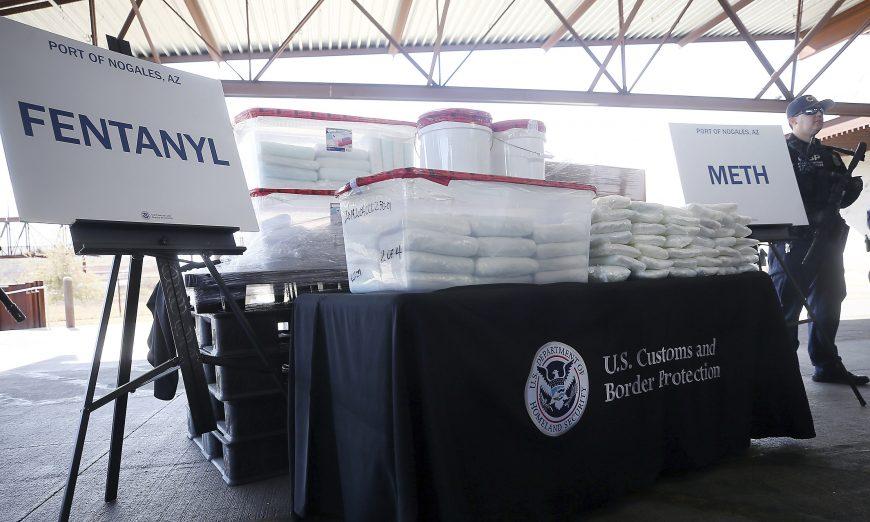
A display of fentanyl and meth seized by U.S. CBP officers at the Nogales Port of Entry is shown during a press conference on Jan. 31, 2019, in Nogales, Ariz. (Mamta Popat/Arizona Daily Star via AP)
In June, U.S. Customs and Border Protection (CBP) seized approximately 2,100 pounds of illicit fentanyl at the U.S. southern border, according to the agency's latest report. The amount is enough to kill every American and then some.
One kilogram (2.2 pounds) of fentanyl can potentially kill 500,000 people, according to the Drug Enforcement Administration (DEA).
"I don't think the public is really aware of what a challenge this is," said Dr. Donna Nelson, an organic chemist and professor at the University of Oklahoma.
"You have to assume that the border agents are not catching everything that's coming into our country," she told The Epoch Times.
"And the amount that's coming in keeps increasing—not steadily, but it is increasing over time."
Ms. Nelson was also the science adviser for the show, "Breaking Bad," and the 2016 president of the American Chemical Society. She was also pivotal in showing how the chemical structure in "bath salts," "spice," and related designer drugs impact a person in a similar manner as illegal drugs.

Today, however, she's turned her research prowess to what she considers an even bigger problem: illicit fentanyl, a synthetic opioid, which she says should be declared a weapon of mass destruction.
Prescription fentanyl is generally prescribed by doctors to treat patients suffering from severe or chronic pain, however, illicit fentanyl has become the source of the majority of overdose deaths in the United States.
Fentanyl and the Border
In fiscal year 2020, CBP seized an average of 445 pounds of fentanyl per month at the southern border. In fiscal 2021, that amount increased to approximately 882 pounds per month. In fiscal 2022, the average amount of fentanyl seized per month was 1,175 pounds.
The total amount for fiscal year 2023 won't be available until October, but CBP has already seized more fentanyl in the first nine months than it did for all of 2022, for an average of 2,427 pounds per month.
In less than three years, the amount of fentanyl seized at the southern border per month has increased more than fivefold.
"Every month, that's enough to kill every person in the United States," Ms. Nelson said.

Ms. Nelson said that while Americans might hear about people dying from fentanyl poisoning, she doesn't think they're "fully aware" of the scope of the problem. To help raise awareness, she organized a symposium on fentanyl during the American Chemical Society’s annual meeting in San Francisco in August.
"The public needs to be alerted about this," she said. "I don't think that they're really that knowledgeable."
She said the symposium will feature leaders in the fight against fentanyl, including a virtual presentation from Rep. Neal Dunn (R-Fla.).
Mr. Dunn introduced a resolution to the U.S. House in January, which would classify illicit fentanyl-related substances as a weapon of mass destruction.
He said the classification will make it easier to curb drug trafficking and free up resources for U.S. law enforcement.
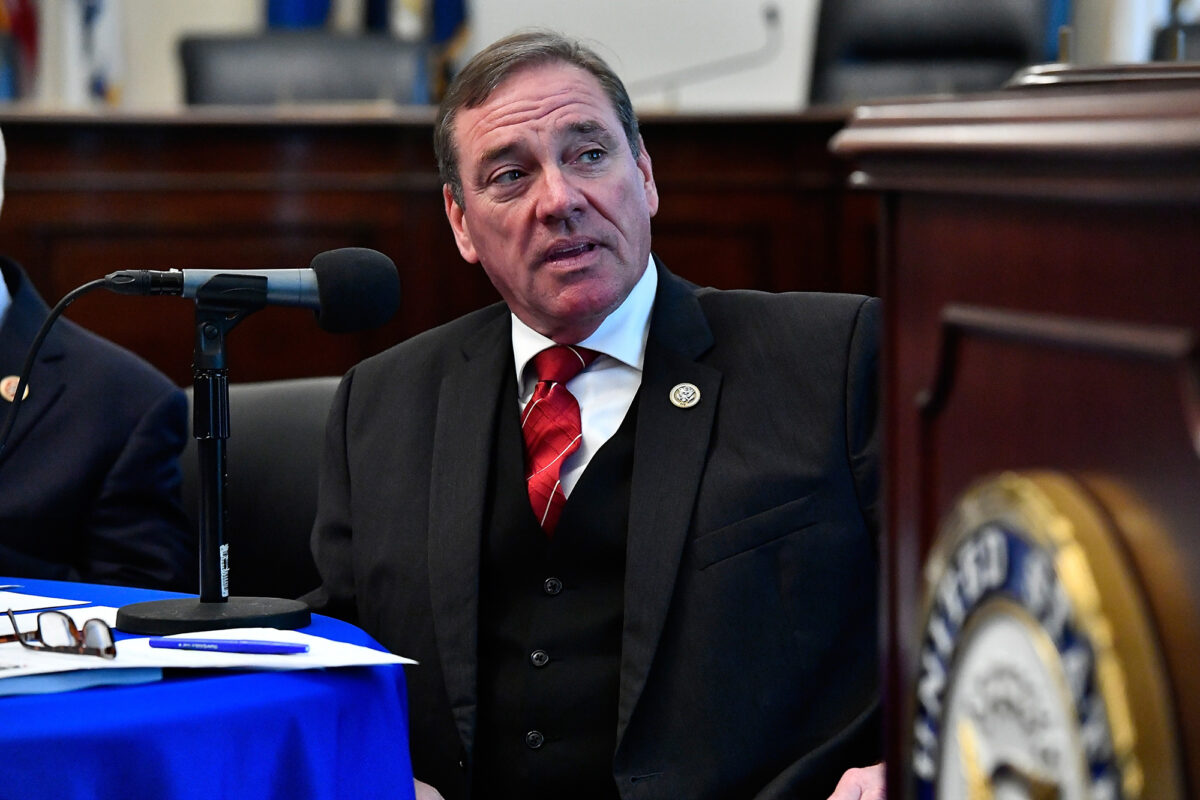
The resolution has been referred to the Subcommittee on Health.
"The House must recognize this dangerous drug for what it really is—a weapon of mass destruction," Mr. Dunn said. "Fentanyl-related substances are tearing families and communities apart, and we must do whatever we can to help law enforcement get them off the streets."
Ms. Nelson testified recently at a congressional briefing at the U.S. Capitol in support of Mr. Dunn's resolution.
During her testimony, she explained that fentanyl presents a unique challenge because of how addictive and deadly it is, that other countries, primarily China, are shipping the precursors of fentanyl to Mexico, which are then combined and smuggled across the southern border, and that scientific research hasn't kept up with the evolving illicit fentanyl crisis.
Escalating Fentanyl Deaths
Synthetic opioids, such as fentanyl, are the primary driver of overdose deaths in the United States, according to the Centers for Disease Control and Prevention (CDC). The DEA reports that fentanyl is involved in more deaths of Americans under 50 "than any other cause of death including heart disease, cancer, homicide, suicide, and other accidents."
For the 12 months ending in Jan. 2022, the CDC reports that 71,238 Americans died from fentanyl poisoning—an increase from 2020, which had an estimated 57,834 deaths.
April Babcock, the founder of Lost Voices of Fentanyl, a nonprofit organization dedicated to raising awareness on illicit fentanyl, told The Epoch Times she thinks those numbers are "significantly underreported."
"There's a family … that's pretty definite their kid died from fentanyl because they found fentanyl at his house. But guess what: He was never tested!" Ms. Babcock said. "[The death certificate] says he died from cocaine. No, he didn't. He died from fentanyl."

She said the family is pushing to get a bill passed in Maryland that requires all hospitals to test for fentanyl if an overdose occurs.
"I hear it all the time: 'They didn't test for fentanyl.' How are we ever going to get the right data?" Ms. Babcock said.
Border Security
On July 12, representatives from the DEA appeared before the House Homeland Security Committee Subcommittee to testify on border security.
As part of its testimony, the DEA issued a statement that said fentanyl "has transformed the criminal landscape."
"Fentanyl is exceptionally cheap to make, exceptionally easy to disguise, and exceptionally deadly to those who take it," the DEA stated.
The agency said it seized more than 58 million fake pills containing fentanyl, and 13,000 pounds of fentanyl powder in 2022.
"This is enough fentanyl to supply a potentially lethal dose to every member of the U.S. population. These seizures occurred in every state in the country," the DEA stated.

Department of Homeland Secretary Alejandro Mayorkas has insisted that the "borders are not open" and that the United States isn't facing a "crisis" at the southern border.
Rep. Clay Higgins (R-La.) disagrees. "The reckless open border policies set by President Biden and Mayorkas have greatly benefited the Mexican cartels," he stated.
"The cartels quickly learned to outmaneuver the system, and with the help of the Chinese Community Party, they have smuggled an unprecedented amount of fentanyl, taken a record number of American lives, brought in billion-dollar profits, and have torn families apart. Secretary Mayorkas' blatant disregard for the security and sanctity of the American people has wounded our great nation deeply."
Mr. Higgins said his subcommittee plans to hold Mr. Mayorkas accountable for "dereliction of duty."
For Help
SAMHSA National Helpline
1-800-662-HELP (4357)
Banks are still losing deposits. Just not the banks you might expect.

The banks that showed some of the biggest deposit declines during the second quarter weren’t midsize regional lenders.
They were the industry’s giants.
JPMorgan Chase (JPM), Bank of America (BAC), Citigroup (C) and Wells Fargo (WFC) — the four biggest banks by assets — gave up a net $262 billion in deposits when compared with the year-earlier period. From the first quarter to the second quarter, customers pulled $62 billion from three of those banks.
Many regional banks, meanwhile, gained deposits back. Investors rewarded them for it, sending their stocks higher over the past two weeks.
The deposit divergence reverses a trend that took hold during a chaotic scramble for safety following the failures of Silicon Valley Bank, Signature Bank, and First Republic. Those seizures led to crippling withdrawals at a number of regional banks during the first quarter and inflows to the industry’s biggest players.
The reason for the reversal in the second quarter is that regional banks now need deposits more than the giants, and they are paying higher rates to get them. The industry titans can afford to keep their rates lower because of their scale, pricing power, and diversity of funding.
"The regionals are winning the deposit battle right now because they’re willing to pay the most," Alexander Yokum, a CFRA equity analyst specializing in regional banks, told Yahoo Finance.
"Ironically," Yokum added, the deposit outflows from the big banks is "actually a sign of strength" for those institutions.
The trend isn’t abating in July, the first month of the third quarter. Deposits at the largest banks in the US dropped $78 billion during the week ending July 12, just days before the start of bank earnings season.
That was the biggest drop since the week ending March 22, when the regional banking crisis was still in full force. Both big and small banks showed small rises the week ending July 19.
Some money is still flowing out of the banking system altogether as customers seek higher yield elsewhere.
One place is to US money market funds. They have received net inflows of $623 billion, two thirds of which came in March and May of 2023. Investors sent $28 billion to these funds over the last week ending July 26.
Read more: The best high-yield money market accounts for July 2023
'The best place for their money'
Banks of all sizes have been struggling to keep depositors well before Silicon Valley Bank’s failure due to pressure being applied by an aggressive Federal Reserve campaign to lower inflation.
During the early part of the pandemic, when interest rates were historically low, banks became awash in deposits. For the two years beginning in March 2020, total deposits in the banking system swelled by 34% to $18 trillion.
When the Fed began moving those rates higher to cool the economy, customers who had deposits began seeking out places with higher yields. The first year-over-year deposit decline for all banks came at the beginning of the second quarter of 2022.
“Any talk of interest rates rising at this point causes people to think about whether their bank is the best place for their money,” Julia Hill, a University of Alabama law professor focused on banking, told Yahoo Finance.
US banks lost $472 billion in deposits in the first quarter, according to a quarterly report from the Federal Deposit Insurance Corporation (FDIC), which was the largest since the FDIC began collecting quarterly industry data in 1984 and marked the fourth consecutive quarter of industry outflows.
The biggest drops during that quarter belonged to certain regional banks. First Republic, for example, lost more than $100 billion and eventually was seized by regulators and sold to JPMorgan.
But some banks that lost deposits during the first showed some of the biggest increases in the second.
Western Alliance (WAL) and Zions (ZION) in Phoenix and Salt Lake City both showed a 7% increase in deposits. At First Horizon (FHN) in Memphis the gain was 6.4% and Comerica (CMA) in Dallas saw a 2% rise.
Even PacWest, a bank that came under intense scrutiny in the spring and agreed to merge with smaller rival Banc of California this past week, showed only a 1% decline in deposits after posting a 17% drop in the first quarter.
The most aggressive deposit rates currently offered are coming from smaller commercial banks, according to Ken Tumin, a senior analyst with LendingTree who runs an online resource called DepositAccounts.com.
Woburn, Mass.-based Northern Bank, the 353rd largest lender in the US with $2.8 billion in assets, currently offers a 5.6% interest on a one year CD.
“A lot of these midized banks in the last several months have been more and more aggressive with deposit rates, especially with CDs,” Tumin said.
This is not entirely good news for some of these smaller banks. By paying more, they are cutting into a key measure of profitability. A number of them revised down their estimates of revenue or lending profits for the rest of the year.
But if these banks don’t pay up, “they can just say goodbye to depositors,” said Yokum, the CFRA analyst.
Friday, July 28, 2023
Parent Activist Group Warns of Chinese Communist Infiltration Into America’s K-12 Classrooms

China's vice chair Xi Jinping unveils a plaque at the opening of Australia's first Chinese Medicine Confucius Institute at the RMIT University in Melbourne on June 20, 2010. (William West/AFP/Getty Images)
The Chinese Communist Party (CCP) has funded Chinese language teaching programs in at least 143 K-12 school districts in 34 states and the District of Columbia, according to a report by Parents Defending Education (PDE), a parent activist group, released on Wednesday.
PDE identifies these Confucius classrooms as “little red classrooms,” an extension of the Confucius Institutes (CIs). CIs are partially funded by the CCP, which picks and pays for textbooks and selects and pays Chinese nationals who come to the United States to teach Chinese language, culture, and history.
In August 2020, the State Department designated CIs’ D.C.-based headquarters as a “foreign mission” of China based on the CIs’ “skewed Chinese language and cultural training for U.S. students as part of Beijing’s multifaceted propaganda efforts,” and that the CI language programs were under guidance from the CCP’s United Front Work Department, the leading agency in charge of influence operations.
“This is not to imply that all Chinese language programs in K-12 schools are evil by any stretch,” Nicole Neily, president of PDE, told The Epoch Times.
“But people should know who is involved in the curriculum, who has oversight, and where their teachers are coming from,” she added. “If the teachers are coming over and have been blessed and approved by Han Ban, then that should raise questions for parents as to what children are learning.
“What version of Chinese history are they learning? Are they learning a one-child or a One China policy? Are they learning about Tibet, Hong Kong, Taiwan, and the Uyghurs, or are they getting a very sanitized version of China?”
Han Ban was known as the CI headquarters. In July 2020, it announced the transfer of CIs to the Chinese International Education Foundation, a self-described “non-governmental charitable organization.” According to a 2023 report (pdf) by the Congressional Research Service, both entities are sponsored by the CCP’s Ministry of Education.
Raising Awareness and Calling for Investigations
Ms. Neily said PDE’s primary objective of raising awareness has been partially achieved. Parents in the school districts named in the report findings contacted PDE with more information and questions.
Beyond equipping families with “complete information” to make educational decisions, Ms. Neily also wants the federal government and governors to investigate the Confucius Institutes in K-12 education.
Currently, the Higher Education Act requires universities to disclose foreign contributions above $250,000. However, there are no similar stipulations for K-12 schools.
After the State Department called out CIs in 2020, 105 CIs in U.S. universities either closed or announced closures, according to a report in June 2022. However, the report by the National Association of Scholars (NAS), a conservative research and advocacy organization, warned that China had rebranded its CIs in U.S. universities; at least 38 colleges have replaced their closed CI programs with similar alternatives.
Several lawmakers have reacted to the PDE findings.
Education and the Workforce Committee Chairwoman Rep. Virginia Foxx (R- N.C.) said in a statement: “It remains our solemn responsibility to slap away the hands of malign foreign actors whenever they attempt to interfere in America’s classrooms. No matter where they may live in our nation, parents deserve reassurance that their children will not be subjected to the propaganda of our nation’s adversaries. Malign doctrine has no place in America’s schools.”
On Wednesday, Rep. Jim Banks (R-Ind.) wrote a letter to U.S. Education Secretary Miguel Cardona, calling for a Department of Education investigation into the CCP’s influence in K-12 classrooms per the PDE report.
Ms. Neily is pleased with the reactions from lawmakers but said, “We would love to have more people to weigh in.”
“In our mind, this is the tip of the iceberg.” She said the PDE findings from four months of research would not have captured the entire picture of the “little red classrooms.”
“I don’t want to put out research just to kind of shout into the darkness; I would like people to do something about it,” she added. “If there were hearings, that would be great.”
She also wants the U.S. Department of Education to take the issue seriously. “Transparency should not be a partisan issue. For families to be able to make informed decisions should be something that every politician should get behind,” she said.
RFK Jr. says Biden administration rejected his request for Secret Service protection in 2024 race

Robert F. Kennedy, Jr. said Friday that his request for Secret Service protection as a 2024 presidential candidate was rejected by the Biden administration.
In a lengthy statement posted on Twitter, the Democratic White House hopeful invoked the assassination of his father, Robert F. Kennedy, during his 1968 presidential campaign.
"Since the assassination of my father in 1968, candidates for president are provided Secret Service protection. But not me," Kennedy wrote.
DEMOCRATS TRY TO CENSOR, REMOVE RFK JR. AT HEARING ON CENSORSHIP
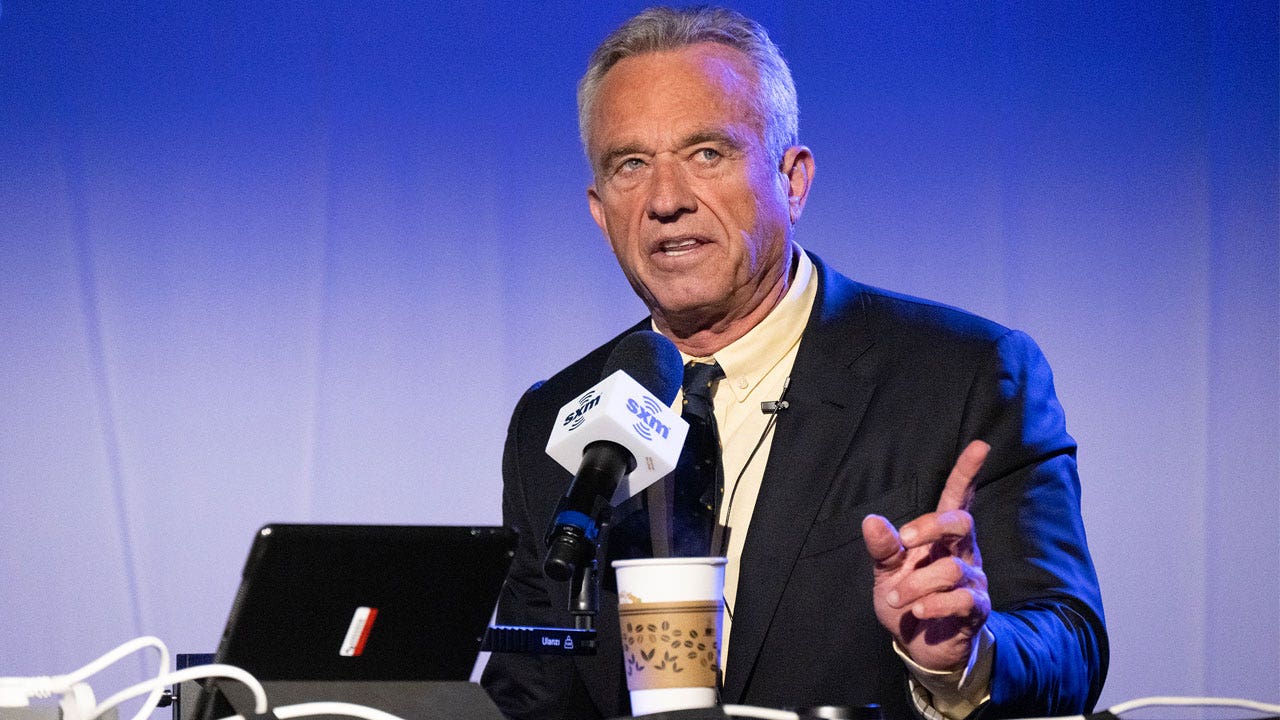
Democratic Presidential Candidate Robert F. Kennedy, Jr. said he was denied Secret Service protection by the Biden administration (Lisa Lake/Getty Images for SiriusXM)
"Typical turnaround time for pro forma protection requests from presidential candidates is 14-days," he wrote. "After 88-days of no response and after several follow-ups by our campaign, the Biden Administration just denied our request."
Kennedy said he received a message from Homeland Security Secretary Mayorkas that read, "I have determined that Secret Service protection for Robert F Kennedy Jr is not warranted at this time."
RFK JR. DENIES BEING ANTISEMITE, EXPRESSES REGRET OVER COVID-19 COMMENTS
"Our campaign's request included a 67-page report from the world's leading protection firm, detailing unique and well established security and safety risks aside from commonplace death threats," Kennedy said.

In his statement Kennedy invoked the 1968 assassination of his father, Robert F. Kennedy (Getty Images)
CLICK HERE TO GET THE FOX NEWS APP
A Secret Service spokesperson referred Fox News Digital to the Department of Homeland Security (DHS) when asked for comment. DHS and the White House did not immediately respond to similar inquiries.
The killing of Kennedy Jr.’s father at a Los Angeles hotel came nearly five years after his uncle, former President John F. Kennedy, was assassinated in Dallas in November 1963.
Elizabeth Elkind is a reporter for Fox News Digital focused on Congress as well as the intersection of Artificial Intelligence and politics. Previous digital bylines seen at Daily Mail and CBS News.
Follow on Twitter at @liz_elkind and send tips to elizabeth.elkind@fox.com
Thursday, July 27, 2023
Senate Backs Ban on China Buying US Farmland

Sprinklers watering a lettuce field in Holtville, Calif., on Feb. 9, 2023. (Sandy Huffaker/AFP via Getty Images)
https://www.theepochtimes.com/us/senate-passes-ban-on-china-purchasing-us-farmland-5423309
On July 25, the U.S. Senate passed an amendment offered by Sen. Mike Rounds (R-S.D.) to ban China and other foreign adversaries from purchasing U.S. farmland and agricultural businesses. The amendment will be included in the Senate version of the National Defense Authorization Act (NDAA) for fiscal 2024.
“China and Russia are our near-peer adversaries, and North Korea and Iran are no friends of the United States,” Mr. Rounds said in a statement emailed to The Epoch Times. “These four adversaries view America as their top competitor and only wish to gain advantage and opportunities to surveil our nation’s capabilities and resources.
“This commonsense provision will make our homeland more secure. I am pleased this amendment was included in this year’s NDAA, and I look forward to working with my colleagues to move this legislation across the finish line.”
The amendment, passed by a 91–7 vote, will also add the secretary of agriculture as a nonvoting member of the Committee on Foreign Investment in the United States (CFIUS), a federal interagency panel that reviews foreign acquisitions for national security risks, and require the president to report to Congress on any waiver granted to entities from the four banned countries.
Mr. Rounds’s amendment also prohibits entities and individuals of the four countries from leasing more than 320 acres or $5 million of agricultural land.
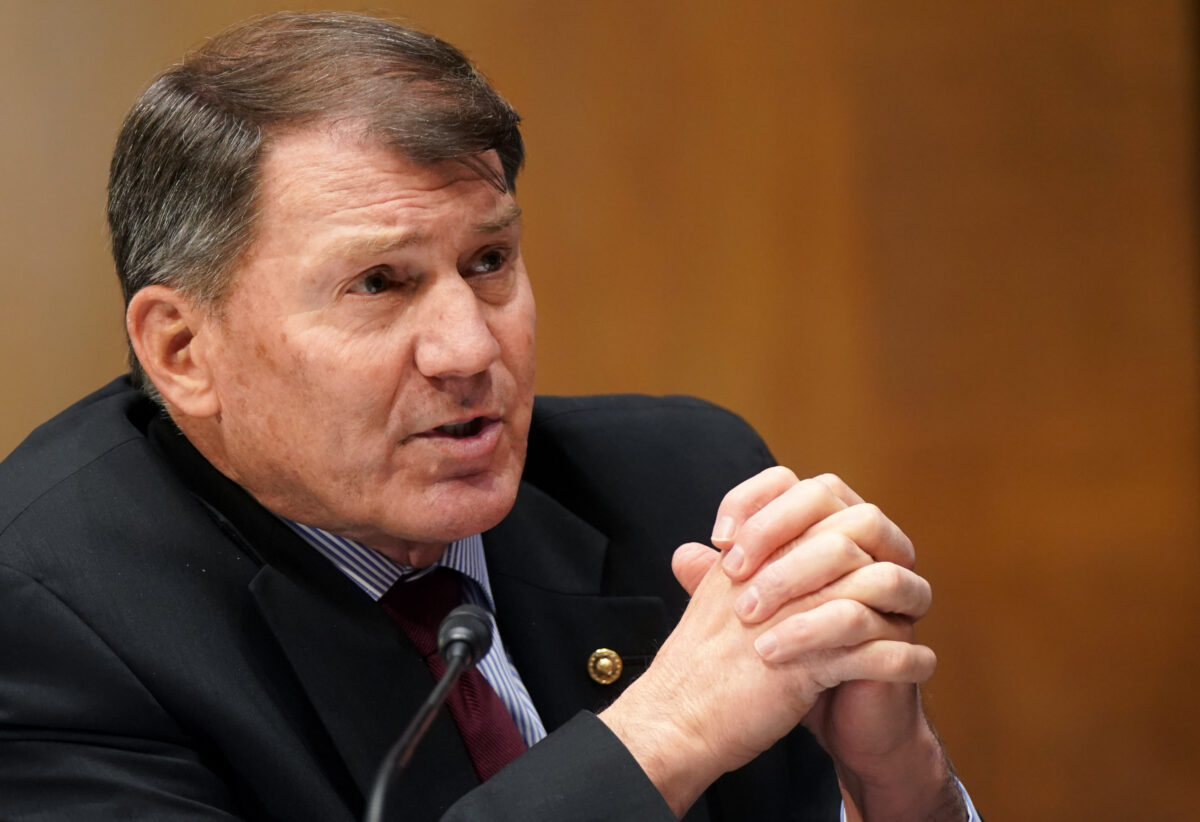
The House version of the NDAA was passed in mid-July. After the Senate passes its version, the House and Senate Armed Services committees will negotiate a compromised final version ready for the signature of the president.
The proposed ban comes when Chinese ownership of U.S. farmland has become an increasing concern for state governments and the general public. Republican-led states such as Florida, Texas, Virginia, and South Dakota have undertaken state-level legislative efforts to tighten control of foreign land purchases.
CFIUS Covered Transaction List Expanded
In May, the Biden administration proposed tighter controls over foreign land purchases by adding eight additional military installations to CFIUS’s list for national security review.
Once finalized, any nonexcepted real estate purchases or leases within 100 miles of those additional sites will be considered a CFIUS “covered transaction,” according to the Federal Register notice.
Some proposed additional sites, such as Grand Forks Air Force Base in Grand Forks, North Dakota, and Laughlin Air Force Base in Del Rio, Texas, were related to high-profile cases that attracted national attention.
In the fall of 2021, a Chinese company bought, through its subsidiary Fufeng USA, 370 acres of farmland to build a corn-milling plant in Grand Forks, North Dakota.
The land is within 15 miles of Grand Forks Air Force Base, which houses sensitive drone, satellite, and surveillance technology and is among the proposed eight additions. In December 2022, CFIUS determined that the land sale for the Fufeng project was “not a ‘covered transaction’” under the committee’s jurisdiction.
The project proceeded until, at the end of January, the Department of the Air Force stated (pdf) that the branch has an “unambiguous” view that “the proposed project presents a significant threat to national security with both near- and long-term risks of significant impacts to our operations in the area.”

The Laughlin Air Force Base is related to another case halted after CFIUS clearance.
In 2016, Chinese billionaire and former military official Sun Guangxin purchased about 140,000 acres of agricultural land in Val Verde County, Texas, and planned to build a wind farm on the property. When the community took note that the proposed wind project would have allowed the Chinese owner access to Texas’s electrical grid and that the property is near the Laughlin Air Force Base, a training ground for military pilots, it raised national security concerns.
In June 2020, CFIUS cleared Mr. Sun’s wind farm project on condition of mitigation agreements, which were reached with the Department of Defense in July 2021. After that, however, the project was halted by a new Texas law that went into effect in June 2021. The Lone Star Infrastructure Protection Act bans Texas businesses and governments from doing business with foreign entities from China, Russia, North Korea, and Iran if these transactions would provide the foreign enterprises remote access or control of critical infrastructure.
Supreme Court Issues Order Allowing Work to Resume on West Virginia Gas Pipe

Justices of the U.S. Supreme Court pose for their official photo at the
Supreme Court in Washington on Oct. 7, 2022. (Front L–R) Justices Sonia
Sotomayor and Clarence Thomas, Chief Justice John Roberts, Justices
Samuel Alito and Justice Elena Kagan. (Back L–R) Justices Amy Coney
Barrett, Neil Gorsuch, Brett Kavanaugh, and Ketanji Brown Jackson.
(Olivier Douliery/AFP via Getty Images)
The U.S. Supreme Court on July 27 allowed Equitrans Midstream Corp. to resume the building of the Mountain Valley Pipeline, granting what some described as a win for Sen. Joe Manchin (D-W.Va.) by lifting a lower-court order that blocked work on the project.
In a brief order (pdf), the high court suggested that it would possibly consider lawsuits issued by environmental groups. “Although the Court does not reach applicant’s suggestion that it treat the application as a petition for a writ of mandamus at this time, that determination is without prejudice to further consideration in light of subsequent developments,” it said.
“The application to vacate stays presented to The Chief Justice and by him referred to the Court is granted,” the Supreme Court added. It didn’t provide any explanation of its decision.
The decision went against the Wilderness Society and other environmental groups that sought an injunction to halt construction. Those groups argued in court that the Mountain Valley Pipeline construction would negatively affect endangered species and said that the Forest Service and Bureau of Land Management violated environmental statutes by approving its construction.
Lawyers cited an 1871 Supreme Court ruling that found that Congress can’t prescribe the rule of decision in a particular case, as that would be an unconstitutional intrusion into the separate powers of the judiciary and would allow Congress “to pick winners and losers,” to quote the groups, in litigation before the federal courts.
Lawyers for the pipeline company said they needed quick Supreme Court action to keep plans on track to finish building the 300-mile pipeline and put it into service by the winter, when the need for natural gas for heating grows. Mountain Valley Pipeline said the work is largely complete, except for a 3-mile section that cuts through the Jefferson National Forest.

The $6.6 billion project is designed to meet growing energy demands in the South and Mid-Atlantic by transporting gas from the Marcellus and Utica fields in Pennsylvania and Ohio.
The project has been delayed by a litany of court challenges. One challenge against the pipeline was upheld by the 4th Circuit of Appeals, which has often tossed out the pipeline’s permits over environmental concerns. The Supreme Court on July 27 ruled on two disputes, one brought by the Wilderness Society and one brought by 10 environmental groups.
Those groups wanted a review from the 4th Appeals Court of authorizations that were handed down earlier this year by the U.S. Fish and Wildlife Service, the Bureau of Land Management, and the U.S. Forest Service that allowed the pipeline segments in the Jefferson National Forest.
Officials Respond
It also comes as Mr. Manchin and several other lawmakers added items into the debt ceiling bill passed last month that sought to allow the pipeline to continue.
“The Supreme Court has spoken and this decision to let construction of the Mountain Valley Pipeline move forward again is the correct one,” the West Virginia senator, who is up for reelection in 2024, said in a statement. “I am relieved that the highest court in the land has upheld the law Congress passed and the President signed.”
West Virginia Attorney General Patrick Morrisey, a Republican, similarly praised the decision by saying that he is “pleased the Supreme Court recognized the importance of this project not only for West Virginia, but for the nation.”
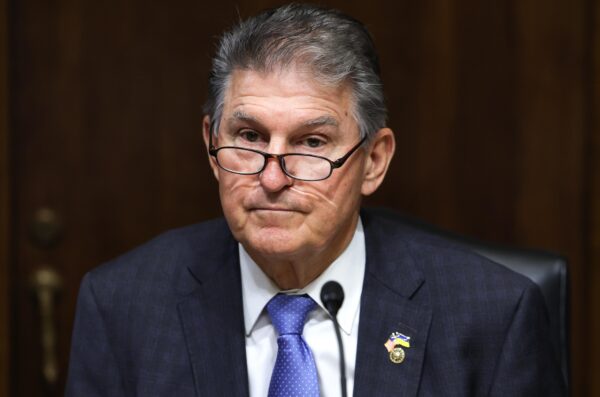
“The Mountain Valley Pipeline is vital to the survival of American energy independence and affects thousands of jobs in West Virginia—its completion is also critical to our national security, the urgent need is for it to be completed as soon as possible,” he said.
West Virginia Gov. Jim Justice spoke about the pipeline at a press briefing on July 26, at which he announced his filing of an amicus brief urging the Supreme Court to restart construction. Mr. Justice said the repercussions of stopping the pipeline would be “terrible” for the state for years to come.
Sen. Shelley Moore Capito (R-W.Va.) called the decision a “major win,” and said in a statement: “All necessary permits have been issued and approved, we passed bipartisan legislation in Congress, the president signed that legislation into law, and now the Supreme Court has spoken: Construction on the Mountain Valley Pipeline can finally resume, which is a major win for American energy and American jobs.”
The Associated Press contributed to this report.
Wednesday, July 26, 2023
How Dubai Became ‘The New Geneva’ for Russian Oil Trade

For decades, the lakeside city of Geneva was home to many of the traders who sold Russia’s oil to consumers around the world. But since Switzerland joined the embargo imposed on Moscow following its invasion of Ukraine much of that trade has shifted to Dubai and other cities in the United Arab Emirates.
Companies registered in the small Gulf state bought at least 39 million tonnes of Russian oil worth more than $17 billion (CHF14.6 billion) between January and April – around a third of the country’s exports declared to customs during that period – according to Russian customs documentation analysed by the Financial Times.
Some of that oil ended up in the UAE, ship-tracking data shows, landing at storage terminals in places such as Fujairah. The rest – about 90% – never touched Emirati soil, instead flowing from Russian ports directly to new buyers in Asia, Africa and South America as part of one of the biggest redirections of global energy flows in history.
The energy trading industry in the UAE was already growing before Vladimir Putin’s invasion of Ukraine. But the conflict, and the western sanctions that followed it, have supercharged that growth.
Out of the top 20 traders of Russian crude in the first four months of the year, eight were registered in the UAE, the customs data shows. In refined petroleum products, such as diesel and fuel oil, UAE dominance was even higher, with ten of the 20 largest traders registered in the country.
The trading boom has further enriched the nation, moving billions of dollars of additional oil revenue through its banks and attracting dozens of new companies to its free-trade zones. It has also tested relations with allies such as the US, which wants Russian oil to flow but is wary of creating new trade routes that undermine sanctions.
Executives at trading houses say Dubai, the UAE’s main commercial centre, is a heady mix of excitement, competition and suspicion as new trading teams battle for talent and trade flow in a market suddenly rife with buyers and sellers.
“If you are an oil trader, this is where you want to be,” says Matt Stanley, a former trader and 20-year industry veteran who now manages client relationships in the region for data provider Kpler. “Dubai is the new Geneva.”
Political neutrality
The UAE, which juts from the Arabian peninsula into the Gulf of Oman, has been an important commercial hub for centuries, attracting merchants who shuttled goods between Europe and Asia. In recent years it has become a major trading location for gold, diamonds and agricultural commodities, such as tea and coffee, helped by its modern business infrastructure, banking services and light-touch regulation.
The UAE is the world’s eighth-largest oil producer, but historically has not been a major oil trading location. Volumes were modest and Adnoc, Abu Dhabi’s state oil company, only set up its own trading arm three years ago.
However, the country’s proximity to growing oil markets in Africa and Asia and the absence of personal income taxes had started to attract more profit-hungry traders even before the war in Ukraine.
“This is one of the last locations in the world to live and not pay tax,” says the chief financial officer of one trading house. Traders in his group’s other offices around the world are now regularly requesting moves to Dubai, he adds. “This will become the global commodity trading hub.”
Another attraction is the UAE’s perceived political neutrality in a world where rivalries between global powers mean Russia is unlikely to be the last country to face European or US sanctions on its exports.
“The UAE gives you that platform to transact, trade and travel freely,” says the chief executive of an energy trading company set up in Dubai in the past five years.
But for all the UAE’s success in building modern business infrastructure and capitalising on its geographical location, it is the war in Ukraine and the UAE’s willingness to welcome Russian businesses that are driving the current boom. “The Ukraine crisis put it on steroids,” the chief executive says.
Russian boom
The Dubai Multi Commodities Centre (DMCC), in the city’s gleaming Jumeirah Lake Towers district, is one of the UAE’s biggest and most successful free zones. A three-dimensional model in the lobby of the headquarters displays the district’s 87 gleaming residential and commercial towers across its two-square-kilometre site, home to 22,000 registered companies.
It is also, arguably, the new centre of the Russian oil trading universe. Out of the 104 buyers of Russian oil listed on Russian customs declarations between January and April, at least 25 were companies registered in the DMCC.
Litasco, a trading arm of Russia’s Lukoil, traded almost 16 million tonnes of Russian crude and refined fuels between January and April worth more than $7 billion, making it the biggest single buyer of Russian oil during the period, according to the customs data. Most of the trading was done by Litasco Middle East DMCC, the declarations show.
The company previously had only a representative office in the UAE, but some of its trading operations moved from Geneva to Dubai last year. One former Litasco trader says the group had taken over an entire floor in a high-rise tower at the heart of the free zone. Switzerland-headquartered Litasco declined to comment.
DMCC-registered Demex Trading and Qamah Logistics are also among the larger traders of Russian crude. Both were incorporated during the past three years; neither could be reached for comment.
Trading Russian oil from Dubai is not illegal. Western sanctions only prohibit imports into the EU, UK and other countries enforcing the G7’s rules, such as Switzerland. Under the restrictions western companies can also continue selling Russian oil to other parts of the world if that oil is sold under a certain price.
The measures have been designed to keep Russian oil flowing to new non-western buyers, while reducing the revenue flowing to the Kremlin. Washington has even encouraged traders to keep moving Russian oil to avoid supply disruptions, provided they trade below the relevant price cap.
While Dubai-registered traders are not obliged to comply with the price cap, some have chosen to do so in order to maintain access to western services such as shipping, banking and insurance.
Geneva-based Gunvor, for example, has said it incorporated a second entity in Dubai in October to segregate “the handling and financing of any potential Russia-related deals” from the rest of its trading activities.
Gunvor had ceased trading Russian crude but bought about $330 million of Russian refined fuels between January and April, all in compliance with the west’s sanctions and price cap policy, it told the FT in June. It disputed some of the customs data, which showed exports by Gunvor worth over $500 million during the period.
Helima Croft, a former CIA analyst and global head of commodities research at RBC Capital Markets, says Washington does not mind where Russian oil is traded from provided it is done transparently. “As long as these Russian barrels are below the cap, these trading houses are doing nothing wrong,” she says. “It’s Washington’s price cap plan in action.”
Other traders, however, appear to be using Dubai-based subsidiaries to buy and sell oil above the cap by employing non-European shipping and financial service providers.
Paramount Energy and Commodities, for example, transferred its Russian trading activity last year from Geneva to a DMCC-registered subsidiary, which has continued to market a crude blend from eastern Russia that has consistently traded above the G7’s $60-a-barrel cap, according to pricing data. Swiss authorities questioned the trader in April about its switch to Dubai, the FT reported in July.
Paramount said at the time that it had responded to the questions in full, informing the regulator that the Swiss entity had ceased all transactions involving Russian oil before the price cap took effect and that its UAE affiliate was a separate legal entity with different directors.
Rosneft’s traders?
The biggest contributors to Dubai’s Russian oil boom, however, are not established players but a network of previously unknown companies with opaque ownership structures that are collectively moving billions of dollars of oil a month.
Among the largest traders of both crude oil and refined fuels from Russia is a company called Tejarinaft FZCO, registered in another free zone called Dubai Silicon Oasis.
Tejarinaft – “oil trade” in Arabic – was incorporated two months after the Russian invasion. Corporate records list Hicham Fizazi, a Moroccan national, as the sole director and the general manager. He is the only named shareholder, although the records do not disclose whether he owns all or part of the company.
Corporate records reviewed by the FT also list Fizazi as the sole director and only named shareholder of at least two other UAE-registered companies trading Russian oil: Amur Trading FZCO, registered in Dubai Silicon Oasis in August, and Amur Investments Ltd, registered in Abu Dhabi in September.
Rival traders say they had never heard of Fizazi before last year. They believe the three companies are part of a network set up by, or on behalf of, Rosneft to help the Kremlin-controlled producer to move its oil after European former partners such as Trafigura and Vitol stepped away from trading Russian crude last year.
Customs declarations suggest that Tejarinaft, Amur Trading and Amur Investments have only ever exported oil from Rosneft or Rosneft projects, trading almost $8 billion of Russian crude and refined fuels from the producer between September and April.
Tejarinaft alone exported $6.71 billion of Russian oil between September and March, exclusively for Rosneft, according to the 394 customs declarations during the period.
Rosneft did not respond to a request for comment. Emails to the address provided on Tejarinaft’s website bounced back as undeliverable, the telephone number listed there connected to a general inquiries line for the free zone while the online “contact us” form did not work. Amur Trading and Amur Investments could not be reached.
Ben Higgins, a Dubai-based investigations specialist at risk consultancy Wallbrook, part of Anthesis, says he has seen a big increase in requests from banks and other corporate clients for further diligence on Dubai-registered trading companies over the past year.
“Incorporated across various Dubai free zones, the target entities are often very low profile and their owners – on paper – aren’t Russian nationals,” he says. “Deeper research and analysis, however, often find multiple leads back to Russia.”
Some of the individuals Wallbrook has investigated also appear to have played similar roles in businesses dealing with oil from Iran or Venezuela, Higgins says, “always a hop ahead of the authorities, shuffling between hotspots such as Cyprus, Hong Kong, Latvia and Dubai”.
‘Faith in the system’
While the Russian oil trading business is scattered across Dubai’s sparkling high-rise offices, the heart of the physical trade is 100 kilometres east at the dusty port city of Fujairah.
The Fujairah Oil Industry Zone (FOIZ) is the largest commercial storage facility in the region for refined oil products. The site’s 262 towering white storage tanks stretch for several kilometres along either side of the road from the port. Right now many of them are filled to the brim with oil, much of it from Russia.
Monthly imports of Russian fuels into Fujairah increased from nothing in April 2022 to a peak of 141,000 barrels a day during December. According to Pamela Munger, an oil analyst at data provider Vortexa, that represented 40% of all fuel flowing into the terminal that month. Last month, Fujairah received an average of 105,000 barrels a day from Russia, the data shows.
The influx has driven up the prices operators can charge for storage but also created a “two tier market, where those tanks willing to take Russian product can charge a premium,” one Dubai-based oil trader said. FOIZ did not respond to a request for comment.
VTTI, which is partly owned by Vitol, is one of a handful of western companies operating storage tanks at Fujairah. VTTI said it did accept Russian fuels into its tanks and stressed that “there are no sanctions in UAE with regards to Russian products, nor are western sanctions applicable to the UAE”.
“Hence, product owners are allowed to move and trade Russian products into and through UAE […] and storage companies are allowed to store Russian product in the UAE,” it said. Even if a cargo was required to comply with the G7’s price cap – for example, because it had been bought or sold by a western company or had used western shipping or insurance services – those restrictions did not apply to the storage provider, it added.
A further sign of the boom in activity at Fujairah was the purchase in May by Dubai-based newcomer Montfort of an oil refinery in the FOIZ previously owned by German utility Uniper. Montfort, set up by former Trafigura trader Rashad Kussad in 2021, outbid several companies including Vitol, which owns a neighbouring facility, according to three people familiar with the deal.
Russian situation was just the start
Montfort declined to comment further on the deal, adding that its commodity trading activities at Fujairah, and elsewhere in the world, comply with “all applicable laws, regulations, and sanctions, including those of the EU, Switzerland, UK and US”.
Such investments in physical infrastructure may have been precipitated by the war in Ukraine, but they also reflect a growing belief in the UAE that even if the Russian-fuelled boom eventually wanes, the global oil trading landscape has been changed forever.
“People put the cause as the Russian situation, but that was just the start of it,” says one UAE-based trading executive, who now expects European commodity bankers to follow the traders to Dubai as Emirati banks seek to expand their service offering for the sector.
For Russian oil, as for many Russian nationals, Dubai has proved to be a welcoming, but potentially temporary, home while the war in Ukraine continues. For the scores of expatriate oil traders manning trading desks across the city, the move looks more permanent.
“It is no longer a transitory environment, where you say: ‘I’ll try my luck and if I lose money I’ll hand back the keys and fly back to Europe’,” says Kpler’s Stanley. “People are now setting up roots here. People have got faith in the system.”
